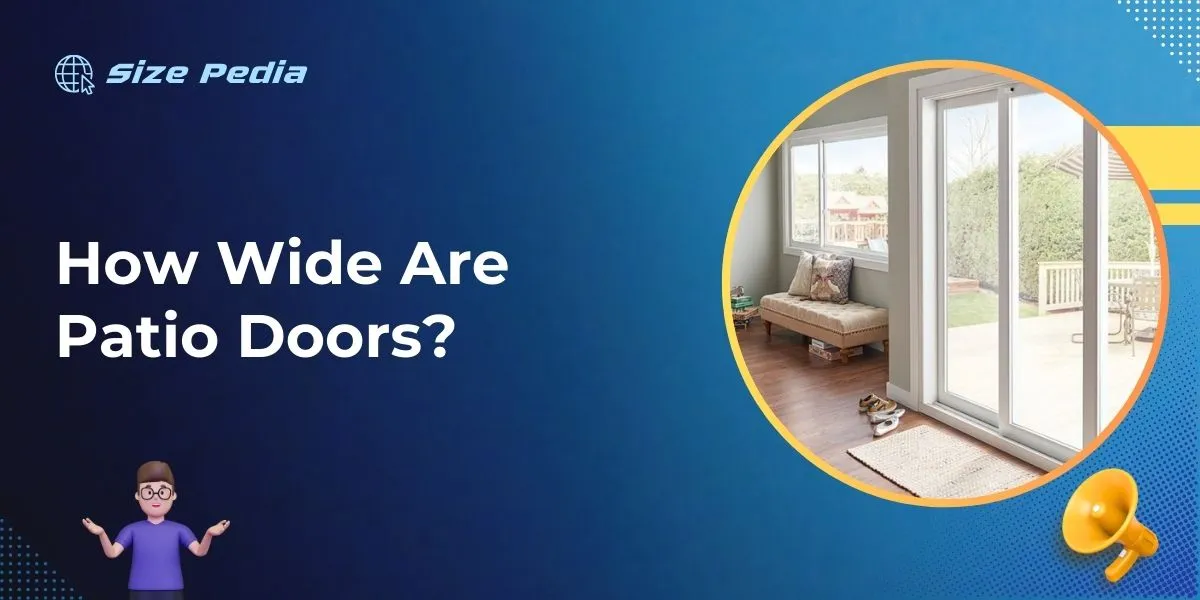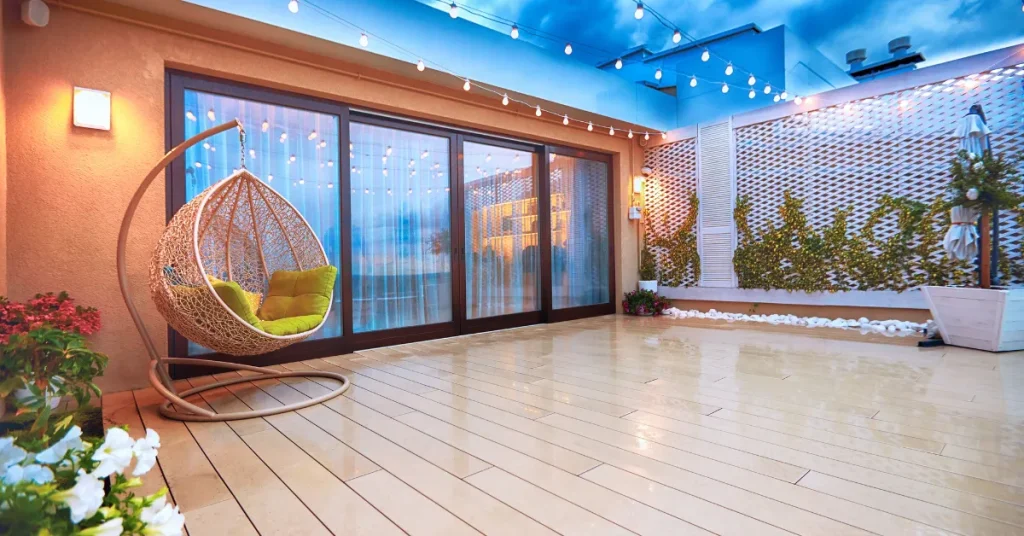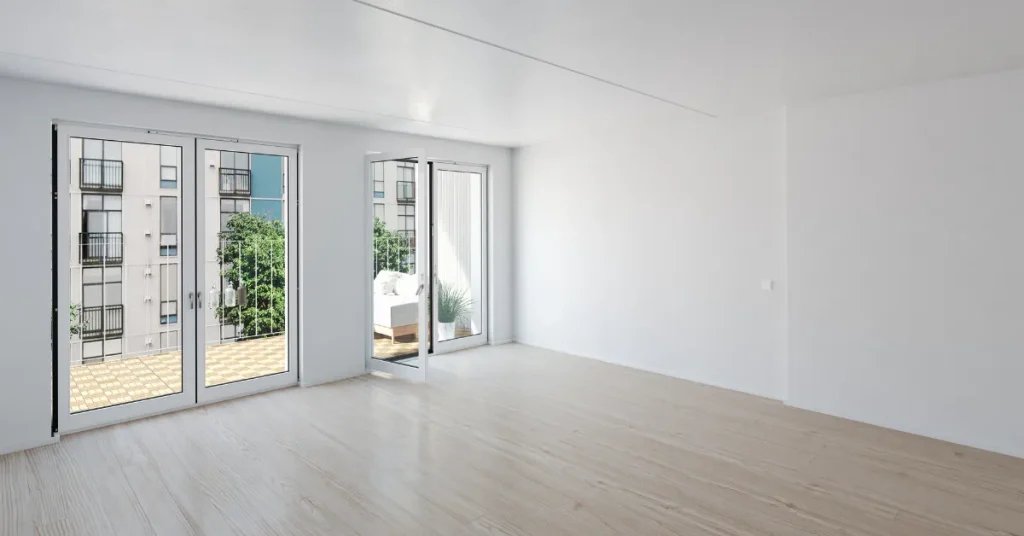Standard patio doors are typically 80 inches in height and range from 60 to 72 inches in width. These dimensions can vary based on custom designs and architectural needs.
Patio doors, also known as sliding glass doors, are a functional and aesthetic feature in many homes, serving as a gateway to outdoor living spaces such as decks and gardens.
Their wide glass panes offer a clear view of the outdoors while allowing natural light to illuminate the interior.
Options include the traditional sliding variety, the elegant French doors, and the modern bi-fold doors, each providing various benefits in terms of space, convenience, and style.
Homeowners might choose a specific type to complement their home’s architecture, enhance energy efficiency, and ensure ease of accessibility.
With safety, durability, and energy conservation in mind, the market offers an extensive selection of materials and technologies in patio door construction.

The Importance Of Proper Patio Door Sizing
Choosing the right size for patio doors is vital. It can change how a living space looks and feels. A perfect fit ensures easy access and enhances home design. A mismatch can cause functionality and style issues, becoming a costly misstep.
Maximizing Functionality And Aesthetics
- Ensure ease of movement: A door too small can restrict passage. A large one may dominate the space excessively.
- Complement space dimensions: Matching door size with room proportions is key to design harmony.
- Avoid installation hassles: Accurate sizing prevents extra modification costs.
Patio door dimensions should enhance a home’s usability. A balance between door size and room layout is essential for optimal door operation.
Impact On Indoor-outdoor Flow
| Door Width | Indoor-Outdoor Connection |
| Narrow | Limited access, feels cramped |
| Medium | Smooth transition, comfortable |
| Wide | Expansive view, easy movement |
Patio doors should bridge indoor and outdoor living. Properly sized doors improve the seamless flow. They enhance natural light entry and ventilation. Large glass doors let more of the outdoors in.
Standard Patio Door Sizes
Choosing the right patio door size is crucial in enhancing your home’s design and functionality. Standard patio door sizes might vary, but they generally fall within recognized dimensions that fit most home structures.
Before selecting a patio door, understanding these measurements is essential. Let’s explore the typical sizes you might encounter.
Typical Width Ranges
The width of patio doors can greatly impact a room’s natural light and access. Most doors come in standard widths like 60, 72, or 96 inches. To suit different spaces and preferences, here are common widths for patio doors:
- 60 inches (5 feet) – Ideal for small balconies.
- 72 inches (6 feet) – Good for medium-sized patios.
- 96 inches (8 feet) – Best for larger, expansive views.
Determining the correct width depends on your space’s requirements.
Height Considerations
Height also plays a pivotal role in patio door size. Standard heights ensure a good fit and proper operation. Common heights for patio doors are 80 inches (6 feet 8 inches) and 96 inches (8 feet). Below is a brief overview:
| Door Height (inches) | Door Height (feet/inches) | Suitable For |
| 80 | 6 feet 8 inches | Most standard installations |
| 96 | 8 feet | Higher ceilings and impressive aesthetics |
Measure your space to see which height aligns with your design and functional needs.
Customized Solutions For Unique Spaces
Think about your unique space needing a special touch. Standard patio doors might not do justice to your ideas. Custom patio doors stand out. They match your style and space needs perfectly.
When Standard Sizes Don’t Fit
Not every home comes with a one-size-fits-all space. Do you have an unusual opening? No worries. Custom doors come in various sizes. This ensures they fit perfectly into your home’s unique design.
Personalizing Your Patio Entryway
Designing your entryway is exciting. Make your patio door reflect your personality. Choose materials, styles, and colors that speak to you. Make a statement with your patio entryway.
- Material: Wood, vinyl, aluminum, or fiberglass.
- Style: Sliding, French, Bifold, or Contemporary.
- Colors: Match or contrast with home exterior.
- Accessories: Handles, locks, grids, or screens add character.
Factors Influencing Patio Door Size Choices

When choosing the size of a patio door, multiple factors come into play. These factors determine not only the practicality of the door but also its aesthetic appeal.
Understanding the influences on patio door sizes ensures that the choice enhances both functionality and design.
Space Constraints And Possibilities
Selecting the optimal size for a patio door demands careful assessment of available space. Considerations include:
- Door Swing: Room for the door to open without hitting furniture or walls.
- Wall Space: Enough wall space for the door installation.
- Outdoor Area: The door should not intrude into the patio or deck space excessively.
Exploring possibilities also means thinking about:
| Aspect | Details |
| Maximizing Light: | Larger doors allow more natural light. |
| Views: | Wider doors offer expansive outdoor views. |
| Air Flow: | Bigger openings improve ventilation. |
Choosing Between Sliding And Hinged Doors
The type of patio door affects the sizing options. Consider the characteristics of each:
Sliding Doors:
- Save space
- Offer larger glass panes
- Ideal for contemporary homes
Hinged Doors:
- Require swing space
- Traditional appeal
- Can open fully for a clear passage
Your choice influences the size and style of your patio door. It’s essential to balance the size with the door’s operation style for the best fit.
Installation Insights
Ready to enhance your home with new patio doors? Knowing the width is just the start. Understanding the installation process is crucial. This section covers key insights into installing new patio doors. Get the best out of your investment by exploring the ins and outs of patio door installation.
Preparing For New Patio Doors
Proper preparation ensures a smooth installation. Here’s how to get ready:
- Measure the space to confirm the size of doors required.
- Check for any structural obstacles that might affect fit.
- Ensure the doorway is square and level for a seamless fit.
- Select the style that complements your home’s design.
- Acquire all necessary tools and materials ahead of time.
Professional Vs. Diy Installation
Deciding between professional help and DIY can be tough. Consider these points:
| Professional Installation | DIY Installation |
| Guarantees expert fitting and finish. | Challenges your skills and might save money. |
| Takes responsibility for measuring and levelling issues. | Requires precision and patience to ensure proper installation. |
| Typically includes warranty and support. | Empowers you to learn a new home improvement skill. |
- Think about your expertise, time, and the tools you own.
- Ready for the DIY route? Follow a detailed guide and take your time.
- Leaning towards a pro? Hire licensed contractors for peace of mind.
Enhancing Your Patio With The Right Door Design

Finding the perfect patio door design is more than just a passage to your outdoor space. It defines the character of your home, impacts lighting, and alters how you interact with your patio.
A well-chosen door can transform a simple patio into a seamless extension of your living area. Let’s explore how varying materials and styles, along with energy-saving and security features, can create the ideal outdoor experience.
Material And Style Selections
Choosing the right material and style for your patio door is crucial. It dictates durability, maintenance needs, and aesthetic appeal. Here’s a quick look at popular options:
- Vinyl Doors: Affordable and low maintenance, ideal for various climates.
- Wooden Doors: Classic and elegant, offering natural insulation.
- Fiberglass Doors: Resistant to warping, swelling, and fading.
- Aluminum Doors: Contemporary and robust, with slim frames for ample glass.
Style-wise, the choices are equally diverse:
- Sliding Doors: Space-saving and modern.
- French Doors: Traditional and charming, inviting open or closed.
- Bifold Doors: For a panoramic view and maximum airflow.
Energy Efficiency And Security Features
Energy-efficient patio doors save on utility bills and provide comfort. Look for features like:
- Double or Triple Glazing: Traps air for better insulation.
- Low-E Coating: Reflects infrared light, keeping heat inside in winter and outside in summer.
- Energy Star Ratings: Relates to the door’s overall energy-saving performance.
For security, opt for:
- Multi-Point Lock Systems: Locks the door at several points for added security.
- Toughened Glass: Reduces the risk of break-ins.
- Quality Frames: Ensures doors can’t be easily forced open.
With thoughtful selection in materials, styles, and efficient features, your patio door will not only look stunning but will also contribute to a safer, more energy-efficient home.
FAQs About How Wide Are Patio Doors
What Is The Standard Size Of A Patio Door?
The standard size of a patio door typically ranges from 60 to 72 inches in width and 80 inches in height.
How Wide Is A 2-panel Sliding Glass Door?
A 2-panel sliding glass door typically measures between 60 to 72 inches in width. Each panel is usually 30 to 36 inches wide.
What Is The Standard Width Of A Patio?
The standard width for a patio ranges between 10 to 16 feet. This width accommodates furniture and enables easy movement.
What Is The Rough Opening For A Standard Patio Door?
The rough opening for a standard patio door typically measures 72 inches wide by 80 inches tall.
Conclusion
Selecting the right patio door dimensions enhances your home’s aesthetics and functionality. Standard widths range from 5 to 12 feet, ensuring a fit for various spaces.
Remember, customization options are abundant for unique needs. Making the right choice will open doors to a brighter, more welcoming home environment.
Resources:
1. https://www.energystar.gov/about/federal-tax-credits/exterior-doors
